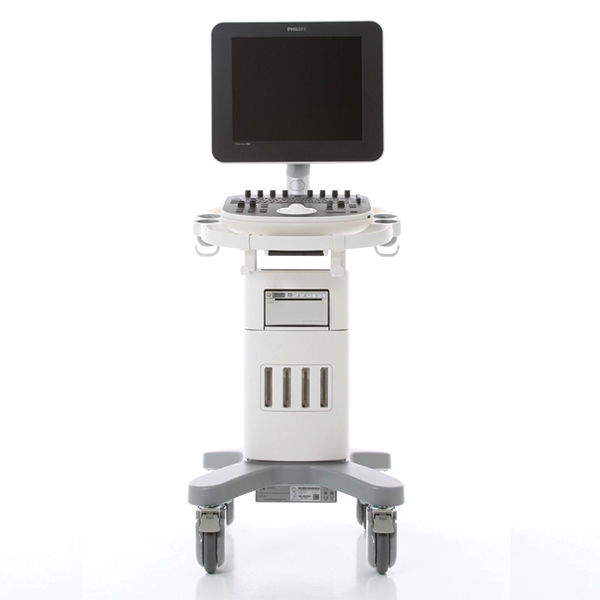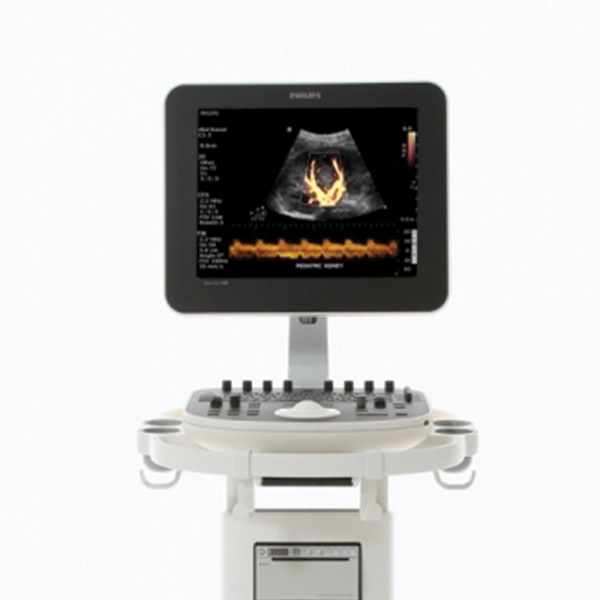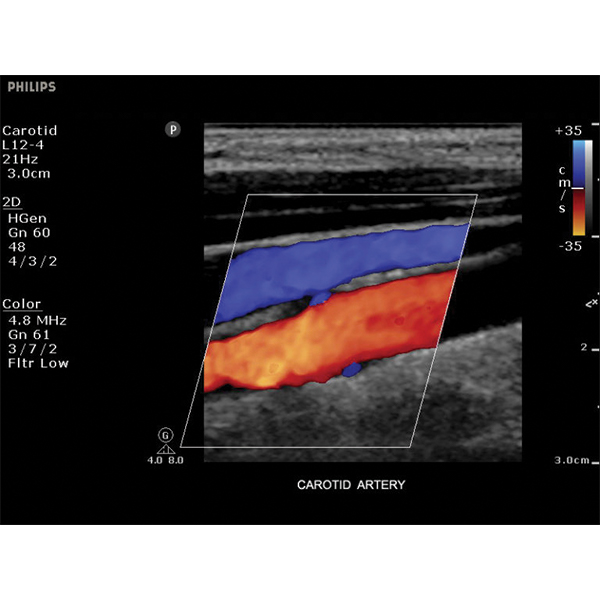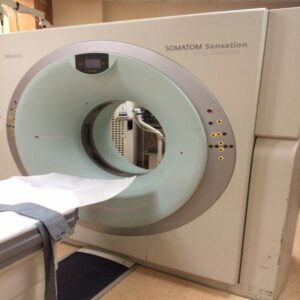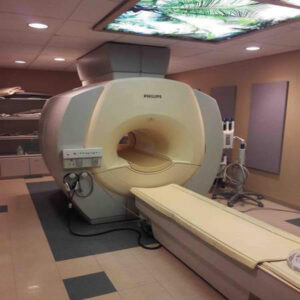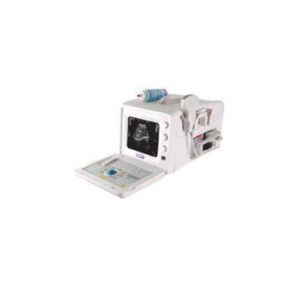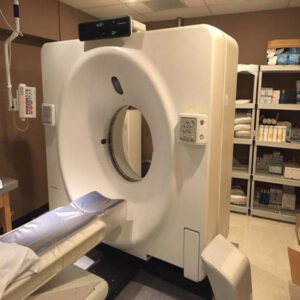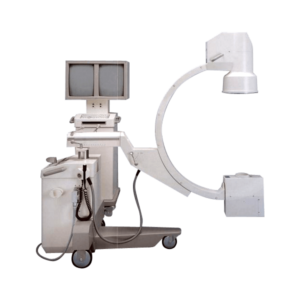Philips ClearVue 550 Ultrasound Machine –
MPIN: MP11732
Sign in to view priceAsk for Quote
Overview
Application training for the ClearVue 550
KPI’s on-staff sonographer can provide onsite applications training or remote training via videoconference for the ClearVue 550 at a set price plus travel costs. A pre-recorded video training course is included in the sale, lease or rental of the ClearVue 550 from KPI ultrasound.
ClearVue 550 Service options
Free technical support is available from KPI during installation and over the course of the standard limited warranty. Technical support is available after the warranty period at an hourly cost per issue.
ClearVue 550 Maintenance
KPI recommends the use of a surge protector along with a dedicated power outlet. Probes should be disinfected after every use with a disinfectant wipe proven not to damage the lens (KPI recommends SonoWipes for this.) KPI recommends one PM visit (preventative maintenance) every year.
Philips ClearVue 550 Dimensions & Weight
Height: (adjustable, maximum) 1160 mm (45.7 in)
Width: 520 mm (20.5 in)
Depth: 584 mm (23.0 in)
Control panel height: (non-adjustable) 837 mm (33.0 in)
Weight: (with printer) 52 kg (115 lbs.), approx. 200 lbs. with packaging
Philips ClearVue 550 Specifications
All-digital broadband beamformer
65,536 digitally-processed channels
Depth to 30 cm (exam and transducer specific)
Up to 272 dB Dynamic Range
Philips ClearVue 550 Electrical power
Voltage: 100 to 240 VAC
Frequency: 50 to 60 Hz
Power: 450VA
Power consumed: 300VA
Heat dissipation: <700 BTUs/hour (fully loaded)
Revisions
Philips ClearVue 550 revisions
Philips first launched the ClearVue 550 in 2012 as version 1.0. The 2.0 update made image quality updates and bug fixes. The 3.0 update added the L12-5 38 linear transducer and upgraded the monitor from 17” to 19”. Version 3.1 added support for the V6-2 4D convex and 3D9-3v 4D endovaginal probes, and added optional 3D fetal echo STIC, strain-based elastography, FloVue, QLAB GI 3DQ, QLAB IMT, Stress, and standard Auto Face Reveal.
All revisions of the Philips ClearVue 550
Philips ClearVue 550 (Rev 1.0)
Philips ClearVue 550 (Rev 2.0)
Philips ClearVue 550 (Rev 3.0)
Philips ClearVue 550 (Rev 3.1)
Common configurations of the ClearVue 550
-
Philips ClearVue 550 with 3 transducers
This is a General imaging (GI) and Women’s health configuration
C5-2 Convex
C9-3v Endovaginal
L12-4 Linear
-
Philips ClearVue 550 with 2 transducers
This is a Cardio/Vascular configuration
S4-1 Cardiac Sector
L12-4 Linear
Probes
All Philips ClearVue 550 probes / transducers
Convex: C5-2 [ 2 – 5 MHz ]
4D convex: V6-2 [ 2 – 6 MHz ] 55mmR, 66° field of view
Endocavitary: C9-4v [ 4 – 9 MHz ] End-fire sector, 11mmR, 180° field of view
4D Endocavitary: 3D9-3v [ 3 – 9 MHz ] 11.5mmR, 150° field of view
Linear: L12-4 [ 4 – 12 MHz ] 21° of trapezoidal imaging
Linear L12-5 38 [ 5 – 12 MHz ] 192 elements,
Cardiac sector: S4-1 [ 1 – 4 MHz ]
Pedoff (CW Transducer): D2cwc [ 2 MHz ] Adult cardiology applications, non-imaging
Advanced Philips ClearVue 550 transducers: 4D
Version 3.0 of the Philips ClearVue 550 (released in 2015) supports two new 4D transducers; the [ 2 – 6 MHz ] V6-2 4D convex is useful not only for creating a 3D baby face image, but more importantly to speed up routine OB/GYN exams by allowing for an entire exam’s worth of 2D images in multiple planes and slices to be captured in a few seconds. The [ 3 – 9 MHz ] 3D9-3v 4D endovaginal transducer also speeds scanning time which reduces patient discomfort but more importantly the 4D endovaginal probe can capture the C-plane of the uterus, something a 2D probe cannot do. This allows for diagnostic certainty in evaluation of a cervical cerclage, placement of an IUD, or a bicornuate uterus where there is a question of only otherwise available through CT or MRI!
Popular ClearVue 550 transducers
The [ 2 – 5 MHz ] C5-2 is the most popular convex transducer for the ClearVue 550, followed by the S4-1 [ 1 – 4 MHz ] adult cardiac sector probe and the [ 4 – 12 MHz ] L12-4 linear transducer.
Competitors
ClearVue 550 comparison with other Philips systems
The Philips ClearVue 550 was launched in 2012 as the modular, next generation replacement for the HD series ultrasound machines, specifically the popular HD7xe. The ClearVue 550 is much more compact and light, and has a larger monitor compared to the HD7 and HD7xe. Though transducer selection is more limited than the HD7xe, the ClearVue 550 now offers 4D and several advanced features such as blood flow in gray scale imaging and stress echo that were never available on the HD7xe. The ClearVue 650 and ClearVue 850 are positioned above the premium economy-level 550 in price and features. The lower cost HD5 is positioned below the Philips ClearVue 550 in price and features.
Philips ClearVue 550 vs ClearVue 350
The Philips ClearVue 550 and the ClearVue 350 were launched at the same time and at the beginning there were features and image quality differences between the early revisions, but as of version 3.1 the only differences are that the 350 does not have the standard articulating arm that the ClearVue550. The two are visually identical except for the monitor arm.
Other brands competing with the ClearVue 550
The closest competitor to the Philips ClearVue 550 from GE would be the Logiq P5 PE which has a very different set of benefits. The ClearVue 550’s strengths are it’s intuitive workflow and design including a larger monitor and image quality supported by technology that has migrated from more expensive Philips units, and cost-effectiveness as an entry-level system. Meanwhile the Logiq P5 has a much broader selection of transducers than the ClearVue 550, allowing it to function in many specialty applications. The closest competitor to the ClearVue 550 from Siemens is the X300 PE, which is more expensive, but like the Logiq P5 offers a broader set of transducers and features than the ClearVue 550. The 550 meanwhile has better greyscale image quality due to newer speckle reduction and image compounding, but the X300 PE has better Doppler sensitivity and access to TEE and ICE transducers. The Samsung R7 is another competitor though the R7 only competes in women’s health and general imaging unlike the ClearVue 550, which is a true shared-service ultrasound machine. The R7 is less expensive than the 550 but has the same monitor size and articulating arm. For scanning effeciency in the most common exams the ClearVue 550 is superior to all competitors, but it is not the best choice for less common specialty imaging situations.
Features
Tissue Harmonic Imaging : Yes
Spatial Compounding(=CrossXbeam) : Yes
Speckle Reduction (=SRI) : Yes
Auto Image Opt(B mode) : Yes
Auto Image Opt(Doppler): Yes
Write Zoom: Yes
Triplex Mode: Yes
Needle Enhancement or Needle Recognition :No
Auto NT Measurement (=Sono NT)
:No
Auto Follicle 2D Measurement:No
Auto Follicle 3D Measurement:No
Auto IMT:No
Auto IMT (Real Time):No
Automated B/M/D Measurement:No
Automated LH Measurement(Automated Function Imaging(AFI), Cardiac Motion Quantification(CMQ), or Auto EF(Ejection Fraction):No
Live Dual (B/BC) Mode:Yes
SmartExam or Scan Assistant:Yes
Fusion:No
Raw Data File:No
Flexible Report:Yes
Barcode Reader:Yes
Gel Warmer:No
Transducers
Convex (1~6Mhz):Yes(C5-2)
Convex (2~9Mhz):No
Single Crystal Convex (1~6Mhz):No
Single Crystal Convex (2~9Mhz):No
2D Arrary 3D Convex (1~6Mhz):No
Micro Convex (5~8Mhz):No
Single Crystal Endocavity_Straight Type (3~10Mhz):
Endocavity_Curved Type (5~8Mhz):Yes(C9-4v)
3D Convex (2~6Mhz):Option(V6-2)
3D Convex Light Weight (2~7Mhz):No
3D Endocavity (3~10Mhz):Yes(3D9-3v)
3D Micro Convex (3~9Mhz):No
3D Linear (4~18Mhz):No
Linear (>14Mhz):No
Linear (3~12Mhz):Yes(L12-4/L12-5)
Linear (<9Mhz):No
Single Crystal Linear (>14Mhz):No
Single Crystal Linear (3~12Mhz):No
Single Crystal Linear (<9Mhz):No
Linear 50mm:No
Linear 25mm:No
Hockey stick (<13Mhz):No
Hockey stick (>13Mhz):No
T or L shape Intra Operative:No
Phased Array_Adult (1~5Mhz):Yes(S4-1)
Single Crystal Phased Array_Adult (1~5Mhz):No
2D Arrary 3D Phased Array (1~5Mhz):No
Phased Array_Pediatric (3~8hz):No
Single Crystal Phased Array_Pediatric (3~8hz):No
Phased Array_Neonate (4~12Mhz):No
ICE (Intracardiac Echo Cardiography):No
TEE_Adult (3-7Mhz):No
TEE_Pediatric (3~7Mhz):No
2D Array 3D TEE (2~7Mhz):No
Pencil CW (2Mhz):Yes
Pencil CW (5 or 6Mhz):No
Imaging Modes
2D, M mode:Yes
M-color Flow Mode:Yes
Anatomical M-mode:Yes
Trapezoidal Mode:Yes
Color, Power Angio, Pulse Wave Doppler:Yes
Bi-directional Power (=HD FLOW):Yes
SCW Doppler:Yes
Tissue Doppler(Velocity) Imaging:No
Freehand 3D:Yes
Live 3/4D OB/GYN:No
HD Live:No
STIC (Spatio-Temporal Image Correlation):No
Live 3D Echo:No
Stress Echo:No
Strain and Strain Rate (Cardiac):No
B Flow:No
Panoramic Imaging (=Logiq view):Yes
Contrast Imaging – Cardiac:No
Contrast Imaging – General Imaging:No
Strain-based Elastography:No
Shear Wave Elastography:No
Applications
Abdominal:Yes
Women’s Health Care (GYN & Breast):Yes
OB:Yes
Fetal Echo:Yes(Option)
Vascular:Yes
TCD(Transcranial):Yes
Small Parts (Breast, Thyroid, Testis…):Yes
MSK/Anesthesiology:Yes
Pediatrics:Yes
Urology (Renal, Prostate…):Yes
Echocardiography_Adult:Yes
Interventional Cardiology:No
Echocardiography_Pediatric:Yes
Echocardiography_Neonate:No
Stress Echocardiography:No
Transesophageal Echo_Adult:No
Transesophageal Echo_Pediatric:No
Internal Medicine w/ Shared Service:Yes
Surgury:No
Interventional Radiology:No
Contrast Imaging _ General Imaging (Low MI):No
Contrast Imaging _ Cardiac (High or Low MI):No
Bowel Imaging:No
Strain Elastography:No
Shear Wave Elastography:No
Specification
System Overview
Year Launched: 2012
Estimated Market Price ($): Economy
Monitor (inch):19″(17″) LCD
Tilt/Rotate Adjustable Monitor: Yes
Monitor Resolution:1280*1024
Image Size Resolution:
Touch Screen (Inch):No
Trackball or Trackpad: Trackball
CP Back-Lighting:Yes
Weight:115 lbs(52kg)
Probe Ports:4
Battery:No
Boot-Up Time:
Sleep Mode (Quick Start):No
Maximum Depth of Field:30cm
Minimum Depth of Field:
Cart (HCU):No
Independent Steer & Lockable Wheels:Yes
Connectivity
DICOM 3.0:Yes(Option)
DICOM SR_Cardiac:Yes
DICOM SR_Vascular :Yes
DICOM SR_OB/GYN:Yes
JPEG, WMV, & AVI:Yes
USB:Yes(3)
HDD/SDD:320GB
DVD/CD RW:Yes
Wireless LAN:No
Shipping Policy
Orders made at Medpick are initiated and processed for shipment upon receipt of request from the customer. Please note that our Shipping Services (Fee, Transportation, Loss or Damage of any shipment, etc.) are in accordance with the Seller\'s terms of Shipment.
Refund Policy
Please refer to Medpick Return Policy.
Cancellation / Return / Exchange Policy
Please refer to Medpick Return Policy.
 REGISTER
REGISTER
 SIGN IN
SIGN IN

